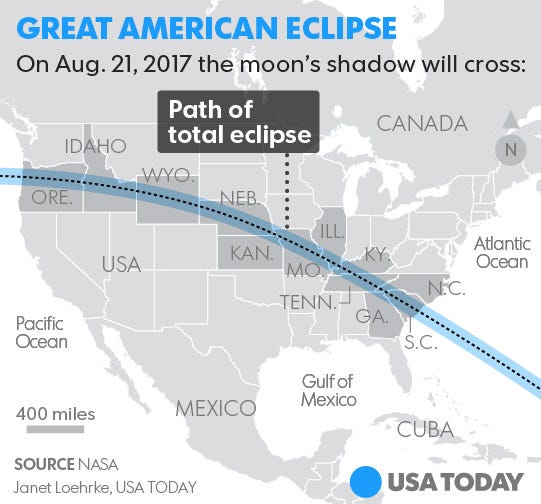Countdown begins: 6 months to the total solar eclipse

Corrections & Clarifications: An earlier version of this story misstated where the total solar eclipse would be visible. It will not be visible in Indiana.
CINCINNATI — Six months. Six months until the grandest show in the heavens returns: the total solar eclipse on Aug. 21. There have been plenty of lunar eclipses and partial solar eclipses in the United States this century, but there has not been a total solar eclipse to touch the mainland of America since 1979. Professional astronomers, amateur star gazers and even casual watchers of the sky are getting excited. So should you.
Here’s what will happen Aug. 21, 2017
Although the exact timing of the eclipse will vary depending on your location, one thing is for sure: On Monday, Aug. 21, the moon will slide in front of the sun. Minute-by-minute, it will block more and more of the sun’s disc, creating an ever-increasing partial solar eclipse. After about 90 minutes, the sun will still shine brightly but will be diminished to a crescent shape. After about another 90 minutes, the sun will slowly return to normal and the eclipse will be over.
► Related:The 'Big One' is coming in 2017: A total solar eclipse
If you’re in the right place at the right time, somewhere within a 75-mile-wide swatch of the country from coast to coast, the moon will block the entire sun in the middle of the three-hour event. It will get eerily dark, dramatically colder, the brighter stars and planets will shine and the sun will appear to have been swallowed whole. This is totality, and it will last a little more than two minutes, and blow your mind.
What you need to decide: Do I stay or do I go?
Will you view the total solar eclipse or merely take in a partial eclipse? Obviously, seeing the total solar eclipse would be preferred. But from anywhere in the United States, you will be able to see a partial solar eclipse. If you want to experience totality, you may have to travel — to parts of Georgia, Idaho, Illinois, Kansas, Kentucky, Missouri, Nebraska, North Carolina, Oregon, South Carolina, Tennessee or Wyoming. See a detailed map of where you need to be here.
Getting away from work or school on a Monday afternoon in order to travel hundreds of miles could be tough. If staying home, 70% to 90% of the sun eclipsed by the moon may be visible. With six months’ notice, there's sufficient time to ask for the day off.

Here’s what you need: Keep it simple
Looking at the sun is dangerous. If even a little sliver of sunlight is showing, you could damage your eyes. The eyes need to be protected when viewing the partial eclipse. Specially filtered telescopes and cameras can be used to view it, but probably the best and safest method for first-time eclipse viewers is to use eclipse glasses or No. 14 welder's glass. When you look through these ultra-dark shades, you can safely look at the sun anytime. However, the view is much more dramatic during an eclipse when you can see the arc of the moon cutting across the solar disc. Buy them early as they may sell out closer to the eclipse.
The only time you can look at the eclipse without special protection is during totality. This is the moment we’ve been waiting for — being at the right place at the right time on Aug. 21. Let’s hope it’s not cloudy in six months.
Follow Dean Regas on Twitter: @DeanRegas